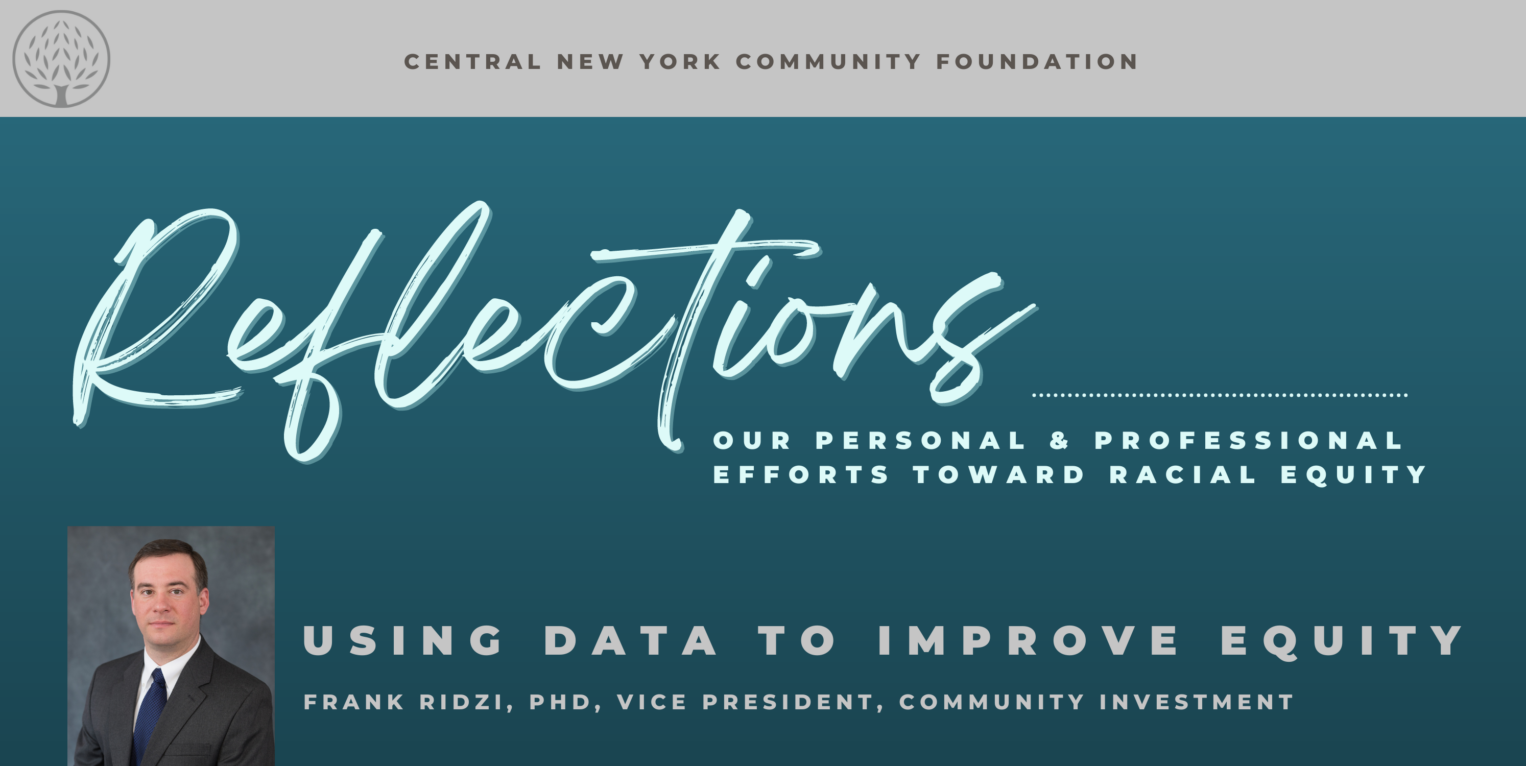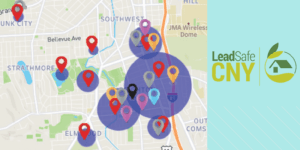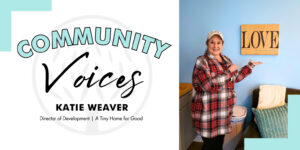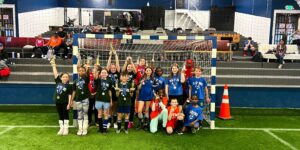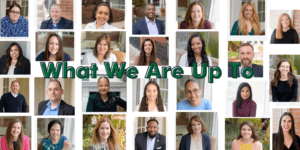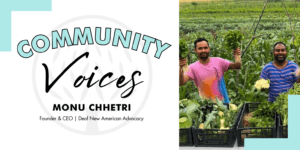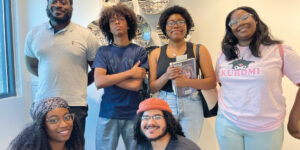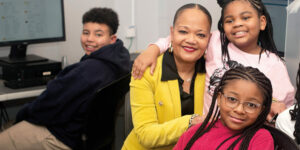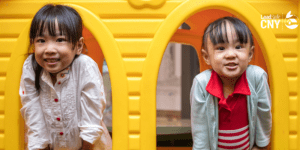Reflections: Our Personal & Professional Efforts Toward Racial Equity is a monthly blog. Each month, a member of our staff will reflect on what they are doing both personally and professionally to improve diversity, equity and inclusion in our work. View more
Many organizations in our region would like to measure how effectively their programs are improving equity in our community, but how can they accomplish this hefty goal when there are so many demands for their time and resources?
Recently I had the honor of meeting a luminary in the field of social policy and equity who helped me focus on that challenge. Angela Glover Blackwell serves as Founder in Residence at PolicyLink, the organization she started in 1999 to advance racial and economic equity for all. In her speech at last year’s international Community Indicators Consortium’s annual conference, she argued, “If you want change, you must use data to understand, to understand what change you need.” In her mind, data offers a “results based North Star” that helps nonprofit organizations and funders design impactful programs.
In her speech she stated:
“Change does not happen if we do not measure how we are doing. We need to have a North Star, and it needs to be a results-based North Star. We need to know: Who? How much? How many? How long? How will we know when we get there? And when we know exactly what that is, we need to measure all along the way so that we can see and feel the indicators. The indicators guide us to the North Star.”
Angela’s words resonated with me and provided a direct response to critics who have suggested that evaluation is the last function that organizations examine through an equity lens. Evaluation scholar Jara Dean-Coffey has asserted that equity evaluation should be focused on creating “a world in which race is not a key determinant of conditions, experience, opportunities, and outcomes.”
This year, three of my colleagues and I are joining Dean-Coffey and a handful of other community foundations to explore how we can make similar social impact in our own work. While we continue to examine data’s role in informing the Community Foundation’s future work in equity, we are already taking action in real-time based on what we are learning.
This year, we built out a new module in the Community Foundation’s free online Life Needs Assessment (LNA) data collection and sharing platform to help local nonprofits to conduct a Diversity Equity and Inclusion (DEI) analysis. This analysis is designed to emulate best practice suggestions in the field. It includes the following:
- Equity Sensitive Community Need Assessment: When we examine community problems such as people not having enough food or needing jobs, it is important that we are able to disaggregate or break up the data so that we can see if certain groups in our community are differently impacted than others. For instance, residents may not have stable housing overall, but certain subgroups, such as individuals with disabilities, may be particularly affected by this problem. According to Awake to Woke to Work: Building a Race Equity Culture, being able to drill down by personal characteristics such as race, age, gender and disability status can help us develop a nuanced understanding of community problems and how they differently impact certain groups. Once we notice certain groups are systematically disadvantaged, we can begin to examine the systems that make this so and start working toward change. This could involve educating against racist actions and building awareness around racist systems in our past and present that continue to affect residents today.
- Equity-Focused Need Analysis: While action sometimes begins with a pressing overall need within the community, this is not always the case. A second important approach can help to detect areas of inequity even when it seems like the community at large or an organization’s clients are doing well. Looking at all outcomes in the community (or an organization’s caseload) according to diversity dimensions such as race, gender, age and ability can help us figure out where gaps and racial disparities exist. While national data and research give a good sense of where racial inequities tend to exist, Awake to Woke to Work points out that it is not until we look at local data from our community or organization that we can see if these do exist here and if we are better off or worse off than other communities or organizations.
- Historical Trend Analysis: Applying historical context to current inequities discovered in either of the two approaches above is an important next step. When we look at inequality, it is critical that we take a long view. While things may be challenging today, are they getting better or worse over time? Are they stagnant? We need to have a sense of these trends not only to provide momentum when we see positive change, but also to help us discern whether current policies and practices are getting us where we want to go. This will help us to determine if they need to be expedited and expanded or whether they are having no effect and a change of course is warranted.
- Diversity Analysis: If organizations and programs are going to make a difference for people, especially sub groups of people who have specific gender, race or ability characteristics, it is critical that we keep track of whether we are actually being successful in reaching those populations. Knowing the answer to this question will tell an organization whether their recruitment and outreach is effective or possibly whether they need to relocate, set up satellite locations, or form partnerships so that the clients they are trying to reach have access to their services.
- Inclusion through Human Centered Design: Life is complex and numbers and statistics alone won’t provide the entire picture. For this reason, reaching out to people experiencing a community problem firsthand (especially if diversity characteristics make this problem more likely to affect them) is a key tool in our toolbox when it comes to designing ways to attack the problem. Furthermore, according to Dean-Coffey, it is these same experts through personal experience that will know when and if the community response is successful. We should use their ongoing reports of lived experience as a key barometer or “North Star” to determine whether we are indeed getting where we want to be going.
Each of these approaches can be a major undertaking on their own, and nonprofits operate within thin margins. As a result, it is common for organizations to lack the capacity to carry out these approaches, even if the will is there. What our new DEI module does is take the challenges of setting up these analyses (and the related data wrangling) and turn them into a series of “easy buttons”. Essentially, it puts DEI program evaluation within reach, giving them a way to easily live out the vision that Angela Glover Blackwell shared. To learn more about how your organization can use our Life Needs Assessment evaluation tool, I can be reached at 315.422.9538 or FRidzi@cnycf.org.
